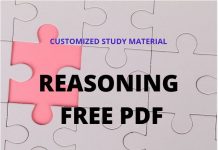 For Daily Job Alert For Daily Job Alert |
Join Our Whats App Channel |
 For Free Study Material For Free Study Material |
Join Our Telegram Channel |
Directions (1-6): Read the following passage carefully and answer the questions given below it. Certain words are given in bold to help you locate them while answering some of the questions.
Have you heard that the economy is like a car? It’s the most popular analogy in financial reporting and political discourse. The American people are repeatedly told by financial pundits and politicians that consumption is an ‘engine’ that ‘drives’ economic growth because it makes up 70% of GDP. One notable Nobel-winning economics pundit with a penchant for bizarre growth theories even recently noted that an economy can be ‘based on purchases of yachts, luxury cars, and the services of personal trainers and celebrity chefs.’ Conversely, other economists including Nobel-winner Joseph Stiglitz claim that our economy is stuck in ‘first gear’ due to inequality: too much income is concentrated among too few rich people who tend to save larger share of their income and thus have a lower ‘marginal propensity to consume’. The Keynesian message is clear: if you want to put the economic pedal to the metal, get out there and consume! Not so fast, Speed Racer. The systematic failure by Keynesian economists and pundits to distinguish between consuming and producing value is the single most damaging fallacy in popular economic thinking. If the economy were a car, consumer preferences would surely be the steering wheel, but real savings and investment would be the engine that drives it forward. Economic growth (booms) and declines (bust) have always been led by changes in business and durable goods investment, while final consumer goods spending has been relatively stable through the business cycle. Booms and busts in financial markets, heavy industry and housing have always been leading indicators of recession and recovery. As John Stuart Mill put it two centuries ago, ‘the demand for commodities is not the demand for labor.’ Consumer demand does not necessarily translate into increased employment. That’s because ‘consumers’ don’t employ people. Businesses do. Since new hires are a risky and costly investment with unknown future returns, employers must rely on their expectations about the future and weigh those decision very carefully. As economic historian Robert Higgs’ pioneering work on the Great Depression suggests, increased uncertainty can depress job growth even in the face of booming consumption. As recent years have demonstrated, consumer demand that appears to be driven by temporary or unsustainable policies is unlikely to induce businesses to hire.
Q1. Choose the word which is MOST SMILAR to the word given in passage
UNKNOWN
(a) Recognize
(b) Perceived
(c) Unpredictable
(d) Unruly
(e) Uncanny
Q2. Which of the following is the most suitable title for the passage above?
(a) Recession and Recovery
(b) Consumer: The driving force for Economy
(c) Economy: a Distant Dream?
(d) Is Consumption necessary for economic Growth?
(e) None of the Above
Q3. In the statement “consumer preferences would surely be the steering wheel, but real savings and investment would be the engine that drives it forward”, what can we infer from the line “consumer preferences would surely be the steering wheel”?
(a) Consumer likings regulate the economy individually.
(b) If you want to regulate the economy, consumption is the only force.
(c) The Penchant of the consumers controls the economy.
(d) The consumer preferences are not at par with savings and economy in driving the economy.
(e) None of the Above
Q4. Which of the following statements is/are correct in context with the passage?
(a) Economists fail to distinguish between consuming and producing value and form a mistaken belief.
(b) Economic growth and declines have always been led by changes in business and durable goods investment.
(c) Income distribution is evenly distributed among the rich and is compatible with the tendency to consume.
(d) Only (a)
(e) Both (a) and (b)
Q5. Which of the following is/are likely to induce businesses to hire?
(a) Consumer Demand
(b) Consumer Spending
(c) Increased certainty in future returns.
(d) Makeshift policies
(e) Both (b) and (c)
Q6. Choose the word which is MOST OPPOSITE to the word given in passage
ANALOGY
(a) Similarity
(b) narrative
(c) Contrast
(d) Reciprocate
(e) Variance
Directions (7-12): Given below the sentences each of which has been divided into five parts out of which the first part has been marked bold. Each of the questions is then followed by the five options which give the sequence of the rearranged parts. You must choose the option which gives the correct sequence of the parts. If the sentence is already arranged or the correct sequence doesn’t match any of the given sequence, mark (e).i.e. “None of the above” as your answer.
Q7. The apex court had ordered that the/ of the biometric scheme and the enabling law(A)/ deadline be extended till the five-judge constitution(B)/ on petitions challenging the validity(C)/ bench delivers its judgment(D)
(a) ACDB
(b) BCAD
(c) BDCA
(d) CADB
(e) None of the above
Q8. Repealing the law that safeguards/ the floodgates of poaching(A)/ and it would lead to(B)/ marginalisation of the indigenous people(C)/the indigenous people would open(D)
(a) DCBA
(b) DABC
(c) ACBD
(d) BACD
(e) None of the above
Q9. My thoughts are with the families/ in this unfortunate accident(A)/ recovery of the injured(B)/ of those who have lost their loved ones(C)/ I pray for the speedy(D)/
(a) BCAD
(b) DACB
(c) ACBD
(d) CADB
(e) None of the above
Q10. Several people became leaders/ remained where they were(A)/ and Ministers after that(B)/ rally but the people(C)/ belonging to the community(D)
(a) ABCD
(b) BCDA
(c) CABD
(d) DACB
(e) None of the above
Q11. He also directed the department/ to develop the new schools as model(A)/ completion of construction work(B)/ construction technology for early(C)/ institutions and engage modern(D)
(a) ADCB
(b) ABCD
(c) DACB
(d) CADB
(e) None of the above
Q12. The U.S. is a/ to its being an open society(A)/ nation of immigrants(B)/ in the present global order(C)/ and owes its predominant position(D).
(a) ADCB
(b) ABCD
(c) BDCA
(d) CADB
(e) None of the above












